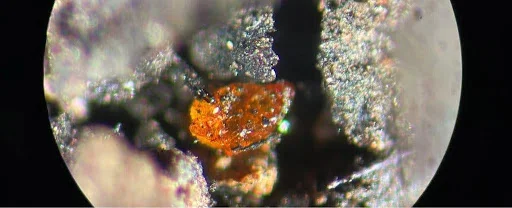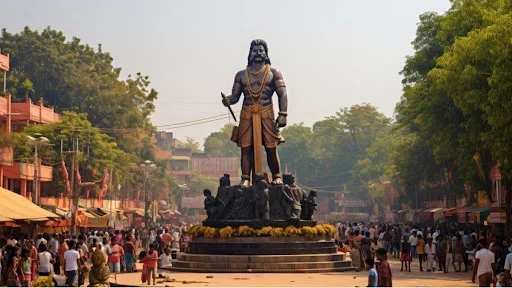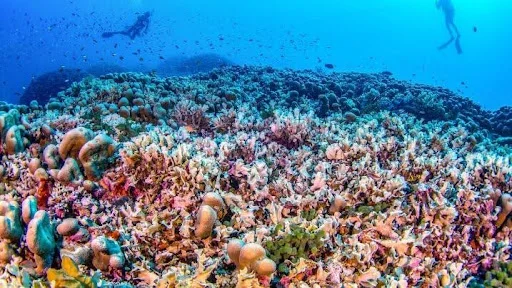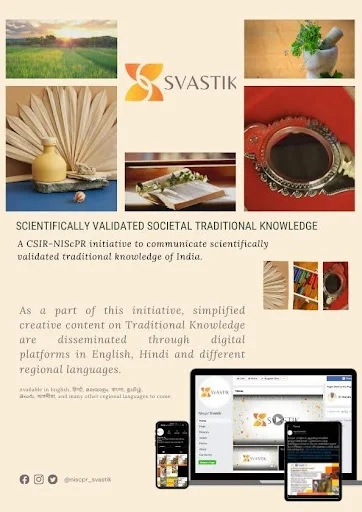UPSC GS 1
Amber
- News: Scientists have recently made a groundbreaking discovery of amber in Antarctica for the first time.
- What is Amber? Amber is fossilized tree resin that has undergone chemical changes and lost volatile components after being buried in the ground, achieving a stable form over time.
- Global Distribution: Amber has been found around the world, with the largest and most significant deposits located along the Baltic Sea. These deposits date back 40 to 60 million years.

- Appearance and Types:
- Amber appears in various shapes, including irregular nodules, rods, or drop-like forms.
- It is most commonly found in yellow shades, with variations of orange, brown, and, less frequently, red.
- Bone amber, a milky-white opaque variety, is also found.
- Amber’s turbidity is sometimes caused by the inclusion of tiny air bubbles.
- Inclusions: Amber often contains fossilized insects and plants, with many hundreds of species preserved within the resin.
- Uses and Value:
- Amber that is deeply colored and translucent to transparent is highly valued as a gem material.
- It is used to make ornamental objects such as beads, rosaries, carved items, cigarette holders, and pipe mouthpieces.
- Amberoid:
- Amberoid (or “pressed amber”) is a synthetic form of amber created by fusing small pieces of amber under pressure.
- This form of amber often displays parallel bands or a flow structure, which can be used to distinguish it from natural amber.
- Importance: Along with fossils of roots, pollen, and spores, the amber provides some of the best evidence yet that a mid-Cretaceous, swampy rainforest existed near the South Pole, and that this prehistoric environment was “dominated by conifers”.
Read also: Bulldozer Justice in India: Controversial Urban Policy
Birsa Munda
- News: Prime Minister Narendra Modi recently paid tribute to Bhagwan Birsa Munda on his birth anniversary, observed as Janjatiya Gaurav Divas.
- Early Life of Birsa Munda:
- Born on November 15, 1875, in Ulihatu village, Ranchi, Jharkhand.
- Belonged to the Munda tribe, a significant tribal group in the Chotanagpur plateau.
- Received Western education at missionary schools but eventually rejected colonial ideologies.
- Identity:
-
- A revered tribal leader, freedom fighter, and folk hero in India.
- Known for his relentless fight for tribal rights and autonomy.

- Opposition to Exploitation:
- Fought against British policies and the exploitation of tribal lands by landlords (dikus) and the colonial administration.
- Land Rights Movement:
- Advocated for tribal autonomy and land protection through the Ulgulan (The Great Rebellion).
- Religious and Social Reforms:
- Proclaimed himself a prophet and spread messages of monotheism, unity, and social reform.
- Cultural Revival:
- Urged tribal communities to return to their traditional culture while rejecting superstitions, alcohol, and missionary influences.
- Religious Movement:
- Founded a new faith combining tribal traditions with revolutionary ideals.
- About the Ulgulan Movement:
-
- Led the Ulgulan in the late 1890s to reclaim tribal lands from British control.
- Sought to establish self-rule for tribal communities and abolish feudal landlordism.
- Mobilized the Munda and other tribal groups to resist through guerrilla warfare.
- Arrested by British authorities in 1900 and imprisoned in Ranchi Jail, where he died under mysterious circumstances on June 9, 1900.
- Inspiration for Tribal Movements:
- His efforts significantly influenced the tribal identity and movements that led to the creation of Jharkhand state in 2000.
- Symbol of Pride:
- Revered as “Bhagwan” (God) by his followers, symbolizing tribal pride and resistance.
- Honors and Observances:
- November 15 is celebrated as Jharkhand Foundation Day and Birsa Munda Jayanti.
Solomon Islands
- News: Researchers have recently identified the world’s largest coral colony in the Solomon Islands.
- Geography:
- The Solomon Islands consist of two parallel chains of volcanic islands and small coral atolls located in the southwestern Pacific Ocean.
- The archipelago comprises nearly 1,000 islands, including six large main islands and over 900 smaller islands, of which 147 are inhabited.
- Neighboring countries include Vanuatu to the southeast and Papua New Guinea to the west.

- Area and Terrain:
- The total area of the Solomon Islands is approximately 461,000 square kilometers, with a landmass of 28,446 square kilometers.
- The country is predominantly mountainous and covered with forests, though it also features some significant plains.
- History and Independence:
- Formerly a British protectorate, the Solomon Islands became an independent republic in 1978.
- Capital:
- Honiara, located on Guadalcanal Island, is the nation’s capital and its largest island.
- Ethnic Groups:
- The population comprises Melanesians (93%), Polynesians (4%), Micronesians (1.5%), and other groups (1.5%).
- Languages:
- English is the official language, with about 120 vernacular languages spoken, including Solomon Islands Pidgin.
- Government:
- The Solomon Islands function as a parliamentary democracy within the Commonwealth, featuring a unicameral Parliament and a ministerial system of governance.
- Head of State:
- The British monarch serves as the head of state, represented by a governor-general elected by Parliament for a five-year term.
Sumi Naga Tribe
- News: The Sumi Naga tribe recently celebrated Ahuna, their traditional post-harvest festival, with a sense of unity and togetherness.
- Tribe Overview:
-
- The Sumi, also known as the Sema Naga, are one of the prominent Naga tribes from Nagaland.
- They primarily reside in the central and southern regions of Nagaland and are the most widespread tribe among the Naga people in terms of settlement patterns.
- Village Settlement:
- The establishment of villages is a key characteristic of the Sumi tribe, with this practice continuing to this day.
- Historically, Sumis were known for establishing villages more frequently compared to other Naga tribes.
- Cultural Practices:
- Before their conversion to Christianity, the Sumis practiced headhunting, a common tradition among many Naga tribes.
- The arrival of Christian missionaries led to a shift in cultural practices.
- Language:
- The Sumi language belongs to the Tibeto-Burman language family.
- Major Festivals:
- Ahuna:
- Ahuna is a post-harvest festival celebrated to express gratitude for the season’s harvest.
- It is also a time to invoke spirits for good fortune in the upcoming year.
- Tuluni:
- The Tuluni festival marks the arrival of the new crop or fruit from the fields.
- It involves prayers to thank God for the abundance of the previous year’s harvest.
- Ahuna:
UPSC GS 2
Know Your Medicine (KYM) App
- News: Union Minister for Youth Affairs & Sports, Dr. Mansukh Mandaviya, has launched a nationwide appeal to strengthen the fight against doping in sports, urging athletes, coaches, and the entire sporting community to embrace the National Anti-Doping Agency (NADA) India’s ‘Know Your Medicine (KYM)’ app.
- Purpose:
- Developed by NADA India to promote anti-doping awareness and education among athletes.
- Aims to ensure athletes have access to crucial information to maintain clean and ethical sporting practices.
- Key Features:
- Allows users to verify if a particular medicine or its ingredients are listed as prohibited by the World Anti-Doping Agency (WADA).
- Offers unique functionalities like image and audio search, making it user-friendly.
- Enables users to select their sport category and find sport-specific anti-doping information easily.
- Impact:
- Promotes informed decision-making among athletes.
- Fosters a culture of fair play and integrity in sports.
- About National Anti-Doping Agency (NADA):
- Establishment:
- Set up by the Government of India as an independent Anti-Doping Organization in November 2005.
- Registered under the Societies Registration Act of 1860.
- Objectives:
- To implement the Anti-Doping Code and ensure compliance by all sports organizations in India.
- To coordinate a doping control program involving all relevant stakeholders.
- To promote research and education on anti-doping to encourage a doping-free sports environment.
- To adopt best practices and quality standards for effective implementation and continuous improvement of the anti-doping framework.
- Nodal Ministry:
- Operates under the Ministry of Youth Affairs & Sports.
SVASTIK
- News: The Director of CSIR-National Institute of Science Communication and Policy Research (NIScPR) recently provided insights on the SVASTIK initiative at the International Conference on Communication and Dissemination of Traditional Knowledge (CDTK-2024).
- What is SVASTIK?
- The Scientifically Validated Traditional Knowledge (SVASTIK) is a national initiative coordinated by CSIR-NIScPR.
- Its main goal is to preserve and perpetuate appropriate traditional practices, encourage the scientific validation of traditions, and strengthen public trust in India’s traditional knowledge and practices.
- Collaborations and Partnerships:
- SVASTIK brings together various research organizations, higher education institutions, experts, and NGOs to document and share scientifically validated content on Indian traditional knowledge.

- Objectives:
- The initiative aims to communicate scientifically validated traditional knowledge to the public, making it accessible and credible.
- SVASTIK stories have been shared across 17 Indian languages on social media to engage a wide audience.
- It has produced two key publications that authenticate traditional knowledge stories, motivating young students to explore science.
- What is CSIR?
- CSIR (Council of Scientific and Industrial Research) is India’s leading publicly funded research and development (R&D) organization.
- It is dedicated to advancing knowledge in natural sciences and engineering, applying its findings for the benefit of society.
- CSIR is a registered society under the Societies Registration Act, 1860.
- CSIR operates a nationwide network consisting of 37 national laboratories, 39 outreach centres, 1 innovation complex, and 3 units spread across India.
- President: The Prime Minister of India holds the position of President (Ex-officio).
- Vice President: The Union Minister of Science and Technology serves as the Vice President (Ex-officio).
- The Director-General is the head of the governing body. Other key members include the Finance Secretary (Ex-officio) and other members who serve for a term of three years.
- Headquarters: The Headquarters of CSIR is located in New Delhi.
Mobility Arrangement for Talented Early-professionals Scheme (MATES)
- News: Australia has set up a new initiative that permits skilled young Indians to live and work in the country for two years.
- Purpose: Provides Indian university graduates and early-career professionals an opportunity to work in Australia for up to two years.
- Launch Timeline: The scheme will open for applications from December 2024.
- Migration and Mobility Partnership Arrangement (MMPA):
- MATES is part of the bilateral framework established under the MMPA.
- The MMPA promotes two-way migration and mobility while addressing challenges related to illegal and irregular migration.

- Eligibility Criteria:
- Age: Open to Indian nationals aged 30 or younger at the time of application.
- Previous Participation: Applicants must not have previously participated in the MATES scheme.
- Language Proficiency: Proficient English skills, demonstrated by an overall IELTS score of at least 6 (minimum 5 in each module) or an equivalent score.
- Education: Must have graduated within the past two years from an eligible educational institution.
- Qualification Fields: Holds a Bachelor’s degree or higher in one of these areas:
- Renewable energy
- Mining
- Engineering
- Information and Communications Technology (ICT)
- Artificial Intelligence (AI)
- Financial Technology (FinTech)
- Agricultural Technology (AgriTech).
- Institution Ranking: Graduates from India’s top 100 universities as per the National Institutional Ranking Framework (NIRF) 2024 rankings are eligible.
- Key Features of the Scheme:
- Duration: Participants can live and work in Australia for up to two years.
- Pilot Programme: The initial phase will offer 3,000 places annually for primary applicants.
- Dependent Inclusion: Participants can apply to bring dependents (spouses and dependent children), who will have work rights in Australia and will not count towards the annual cap.
- Visa Flexibility: Visa holders have 12 months to make their first entry into Australia. They can stay for 24 months from the date of their initial entry. Multiple entries to Australia will be allowed during the visa period.
Read this: Rise of Women in Indian Politics: Challenges, and Progress | UPSC
UPSC GS 3
Operation Dronagiri
- News: The Secretary of the Department of Science and Technology (DST) recently launched Operation Dronagiri at the Foundation for Innovation and Technology Transfer (FITT), Indian Institute of Technology Delhi, New Delhi.
- Pilot Project:
-
- Operation Dronagiri is a pilot initiative under the National Geospatial Policy 2022 aimed at showcasing the potential applications of geospatial technologies.
- It seeks to improve citizens’ quality of life and facilitate business activities through enhanced geospatial solutions.
- Goals and Objectives:
- The project is part of DST’s efforts to liberalize geospatial data, develop geospatial infrastructure, and promote geospatial skills, knowledge, and standards for policy implementation.
- Phase One:
- The first phase of Operation Dronagiri will be implemented in the states of Uttar Pradesh, Haryana, Assam, Andhra Pradesh, and Maharashtra.
- It will demonstrate the integration of geospatial data and technologies across three key sectors:
- Agriculture
- Livelihoods
- Logistics and Transport
- Partnerships:
- Several government departments, industries, corporations, and startups will be involved in the first phase, helping to lay the foundation for a nationwide rollout.
- Support Infrastructure:
- The project will be supported by the Integrated Geospatial Data Sharing Interface (GDI), providing spatial data accessibility and driving transformation.
- Oversight:
- The activities under Operation Dronagiri will be supervised by the IIT Tirupati Navavishkar I-Hub Foundation (IITTNiF).
- Operational Arms:
- The Geospatial Innovation Accelerators (GIAs) at IIT Kanpur, IIT Bombay, IIM Calcutta, and IIT Ropar will act as operational arms for the project.
- Implementing Agency:
- The Geospatial Innovation Cell, Department of Science and Technology, will be responsible for driving the implementation process.
Facts for Prelims
World Diabetes Day
- News: World Diabetes Day was recently observed to raise awareness about diabetes, emphasizing its prevention and management.
- Date and Significance:
- World Diabetes Day is celebrated annually on November 14.
- This date marks the birthday of Sir Frederick Banting, who co-discovered insulin in 1922 alongside Charles Best. Their breakthrough has significantly impacted the treatment of diabetes and improved the lives of millions.
- Theme for 2024:
- The theme for World Diabetes Day 2024 is “Access to Diabetes Care: Empowering Better Health for All.”
- History:
- Inception:
- World Diabetes Day was first established in 1991 by the International Diabetes Federation (IDF) and the World Health Organization (WHO) in response to the rising global concern over diabetes.
- UN Recognition:
- In 2006, the United Nations officially recognized World Diabetes Day, turning it into a global observance.
- Objectives:
- The day highlights the challenges faced by individuals with diabetes, including the need for better access to healthcare.
- It raises awareness about the lifestyle changes that can reduce diabetes risk.
- Celebrations:
- Events include awareness campaigns, educational seminars, health check-ups, and fundraising activities.
- Blue Circle Monuments around the world are illuminated to symbolize global unity in the fight against diabetes.
- People are encouraged to wear blue to show their support for diabetes awareness.
- What is Diabetes?
- Definition:
- Diabetes mellitus, commonly known as diabetes, is a metabolic disorder characterized by persistently high blood sugar levels.
- Cause:
- Diabetes occurs when the pancreas either produces insufficient insulin or the body cannot effectively use the insulin it does produce.
- Insulin is a crucial hormone for regulating blood sugar levels.
- Complications:
- If insulin does not function properly, elevated blood sugar levels can lead to complications affecting the heart, kidneys, feet, and eyes.

